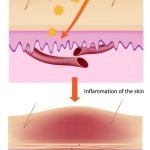Major Breakthrough in Cystic Fibrosis Screening using Wearable Sensor
A new type of wearable sensor may be replacing current methods for diagnosing cystic fibrosis, and also providing real-time monitoring for other disease states. New research on a wearable sweat sensor is a major breakthrough in analyzing sweat to determine metabolic changes and possible disease states. Current diagnostic measures for cystic fibrosis – a genetic condition leading to the accumulation of thick, viscous secretions in the lungs, pancreas, liver, intestine, and reproductive tract, and to increased salt content in sweat gland secretions – involve sitting still while electrodes stimulate sweat gland secretion. This can take about 30 minutes, and is especially difficult since most individuals being screened are children. After the sweat stimulation and collection, the sweat needs to be assessed in a lab.
How it Works
This new wearable sensor1 connects to a smartphone and is able to collect the sample (needing far less sweat than before) and analyze it in real-time. The sensor uses an iontophoresis process to stimulate the sweat glands through electrical current. It is a 2-part system of flexible sensors and microprocessors that sticks to the skin. It stimulates the sweat glands and then detects the presence of different molecules and ions based on their electrical signals. The sensor is built into a wristband that can be easily worn. The research team is hopeful that this technology will be able to be utilized in primary care settings as well as areas in the world where conventional cystic fibrosis testing has never been available.
Also Analyzes Other Molecular Constituents
The sensor can analyze for other molecular constituents besides chloride ions, such as glucose. In fact, the research team did look at the correlation between blood glucose and sweat glucose concentration, and found a distinct correlation when a bolus of glucose was administered. In the future these types of monitoring devices may be able to aid in diabetic management, as well as warn when a viral infection has started in someone. The fact that such a little amount of secreted material can be utilized for analysis is a huge step in developing various uses for this technology.
Source:
- Emaminejad S, Gao W, Wu E, et al. Autonomous sweat extraction and analysis applied to cystic fibrosis and glucose monitoring using a fully integrated wearable platform. Proc Natl Acad Sci USA. 2017.
 Node Smith, associate editor for NDNR, is a fifth year naturopathic medical student at NUNM, where he has been instrumental in maintaining a firm connection to the philosophy and heritage of naturopathic medicine amongst the next generation of docs. He helped found the first multi-generational experiential retreat, which brings elders, alumni, and students together for a weekend campout where naturopathic medicine and medical philosophy are experienced in nature. Three years ago he helped found the non-profit, Association for Naturopathic ReVitalization (ANR), for which he serves as the board chairman. ANR has a mission to inspire health practitioners to embody the naturopathic principles through experiential education. Node also has a firm belief that the next era of naturopathic medicine will see a resurgence of in-patient facilities which use fasting, earthing, hydrotherapy and homeopathy to bring people back from chronic diseases of modern living; he is involved in numerous conversations and projects to bring about this vision.
Node Smith, associate editor for NDNR, is a fifth year naturopathic medical student at NUNM, where he has been instrumental in maintaining a firm connection to the philosophy and heritage of naturopathic medicine amongst the next generation of docs. He helped found the first multi-generational experiential retreat, which brings elders, alumni, and students together for a weekend campout where naturopathic medicine and medical philosophy are experienced in nature. Three years ago he helped found the non-profit, Association for Naturopathic ReVitalization (ANR), for which he serves as the board chairman. ANR has a mission to inspire health practitioners to embody the naturopathic principles through experiential education. Node also has a firm belief that the next era of naturopathic medicine will see a resurgence of in-patient facilities which use fasting, earthing, hydrotherapy and homeopathy to bring people back from chronic diseases of modern living; he is involved in numerous conversations and projects to bring about this vision.









